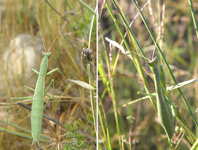Abstract
The genus Apteromantis Werner, 1931 comprises two species of wingless mantids, the Iberian A. aptera (Fuente, 1894) and the North African A. bolivari (Werner, 1929). Although A. aptera and A. bolivari have been traditionally considered as separate and valid species, their external appearance is quite similar and no comprehensive taxonomic study has analyzed their morphological and genetic characteristics. This taxonomic uncertainty has important implications for conservation because A. aptera is considered an Iberian endemic and the only praying mantis protected by international laws. In this study, we apply a comprehensive approach, including quantitative morphological and molecular analyses, to shed new light on the taxonomic and conservation status of the genus Apteromantis and the putative species. We have found that the Iberian and North African specimens analyzed herein significantly differ in female head shape, male genitalia morphology and several other traits related to body size. Molecular data suggest the presence of two main lineages, with sequence divergence rates of approximately 4 %, which are within the range reported for other well defined insect species. Overall, this study supports that A. aptera and A. bolivari are valid species despite their ecological and morphological similarity and highlights the importance of comprehensive approaches to resolve old taxonomic and conservation problems.

